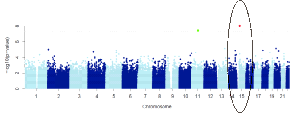Genomewide association study of bisphosphonate-related jaw osteonecrosis Objectives: Osteonecrosis of the jaw (ONJ) is a potentially severe adverse effect of antiresorptive agents including bisphosphonates and denosumab. ONJ occurs in ≤7% of individuals using bisphosphonates, with approximately half of them not presented with traditional predictive risk factors such as dental extraction. Therefore, a genetic predisposition has been proposed. Genomewide association studies (GWAS), widely performed in pharmacogenomics and successful in other drug side effects, were attempted in ONJ. However, possibly due to small cohort sizes (≤30 cases), these previous GWAS failed to detect any significant genetic factors for ONJ. The purpose of this report is to present preliminary results of a GWAS in ONJ, in a large, multicentre, well-phenotyped cohort. Methods: The GENVABO consortium was set up in 2008. GENAVBO stands for genetic variants as biomarkers of jaw osteonecrosis associated with bisphosphonates. Between 2008 and 2012, 393 ONJ cases were recruited from 22 clinical centres worldwide. The diagnostic criteria included exposed and non-exposed ONJ. All cases were thoroughly phenotyped and adjudicated by specialist multidisciplinary teams. Genomic DNA was isolated from peripheral blood using QIAamp DNA Blood Mini Kit. All case samples were genotyped using Illumina HumanOmniExpressExome-8v1 chip (951,117 markers) and were compared with >2,000 genetically-matched population controls from publicly available sources. Statistical analysis was performed in PLINK. The association between ONJ development and single nucleotide polymorphisms (SNPs) was analysed with logistic regression and Fisher’s Exact test. Results: With extreme phenotyping, i.e. non-surgery triggered ONJ cases versus population control, a genomewide significant (p<5E-8) SNP was identified - rs12440268 at gene TJP1 in chromosome 15, p=9.53E-9. Individuals positive for this marker were nearly 3 times more likely to develop ONJ than those negative for it, OR=2.74.
Discussion: For the first time, a genomewide significant SNP was identified. TJP1 encodes an intercellular tight junction protein, which may support one of the ONJ pathophysiology hypotheses “soft tissue toxicity”. Conclusion: The GENVABO study confirms the role of genetic susceptibility in ONJ development; personalised medicine, i.e. the right patient with the right drug at the right dose at the right time, in ONJ prevention awaits.
|


